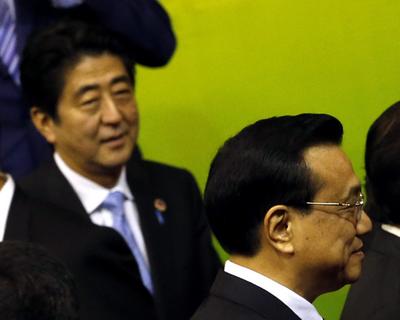This was underlined when a Chinese military vessel locked its radar onto a Japanese destroyer in the area in January 2013.
Thankfully, cool heads prevailed.
But this was not the end of the mutual provocations and recent months have witnessed a depressingly predictable reopening of old wounds. This has included a denial of the Nanjing Massacre by a board member of Japan’s national broadcaster. Most notably, Prime Minister Shinzo Abe visited Yasukuni Shrine on 26 December 2013 — becoming the first serving prime minister to do so in more than seven years. The last prime minister to visit during his tenure was Junichiro Koizumi who paid six visits to the shrine in five years. This brought China–Japan political relations at the highest level to a virtual halt.
These events are taking place against the backdrop of Japan’s increasingly assertive foreign policy discussion that inevitably raises concerns in China.
To seasoned observers of China–Japan relations, this could easily feel like deja vu. Abe was an ardent supporter of Koizumi’s visits to the shrine and perhaps the biggest surprise is that he did not visit during his first spell in office after succeeding Koizumi in 2006. Similarly, the other historical slights are nothing new; diplomatic ‘slips of the tongue’ have dogged Japan’s relations with its neighbours for decades. The latest round of the Senkaku/Diaoyu dispute certainly looks serious, but so did many of the other incarnations of this thorn in the side of bilateral relations. From the fleet of armed Chinese fishing ships that approached the islands in 1978, to the lighthouse incident of 1996, and the more recent boat ‘collision’ of 2010, this issue has never gone away.
If the issues are not new, then neither is the pessimistic and occasionally hysterical tone of much of the commentary that has accompanied them. Predictions that the two countries were preparing for war in 2013 plainly did not come to pass. Still, just weeks into 2014 there are similar warnings circulating, including from a senior figure in the US Navy. Such predictions are understandable — they fit much of the short-term evidence and the academic discipline of international relations is so preoccupied with military conflict that it looks for it wherever relationships do not run smoothly — but they are consistently wide of the mark. The resilience of the China–Japan relationship and its ability to withstand seemingly intolerable levels of discord should not be underestimated. It is easy to find possible causes of a conflict between China and Japan, but it is substantially more difficult to find evidence that senior decision-makers on either side would allow that to come to pass.
China’s increasingly assertive activity in the East China Sea and its declaration of the Air Defence Identification Zone are clearly matters of concern for anyone who cares about regional stability. Similarly, the increased willingness of leading Japanese figures to engage in insensitive acts and undiplomatic language over the thorny issue of history while continuing to push for constitutional reform can only further antagonise a sensitive China. So we should not dismiss recent events as just another round of Sino–Japanese cyclical tension.
China’s reaction to Abe’s Yasukuni visit might have appeared relatively restrained, but China reacted in much the way that it always has on this issue: with rhetorical indignation from relatively low level foreign ministry spokespeople and critical commentary in official media. The real cost to Abe of his shrine visit was to break what appeared to have become an institutionalisation of prime ministers staying away from the shrine. This certainly will harm his ability to conduct relations with Japan’s neighbours — in particular China — in any worthwhile manner for the remainder of his tenure.
Still, one of the most remarkable aspects of the damage done to the bilateral relationship by the Yasukuni issue under Koizumi was just how quickly it was repaired once he was out of office.
It certainly feels like Japan and China have been here before, but that is because they have. We should not casually dismiss the current situation as a storm in a teacup, but it benefits nobody — least of all China and Japan — to overplay the potential for the situation to spiral further.
Ed Griffith is a postgraduate research student at the University of Leeds, UK and a fellow of the White Rose East Asia Centre.


The overwrought speculation about impending war are not limited to the media. Abe, at World Economic Forum, said the situation in East Asia reminded him of 1914. I don’t know whether he saw Japan as France or Great Britain. But clearly, China was Germany.
That’s a fair point. Some of the rhetoric (from both sides) is inflammatory and unnecessarily so. But I don’t think Abe’s comments about China being like Germany in 1914 were anything more than another shot in the public relations battle.